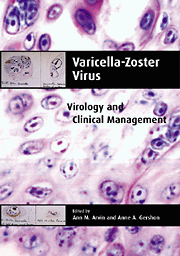Book contents
- Frontmatter
- Contents
- List of contributors
- Preface
- Introduction
- Part I History
- Part II Molecular Biology and Pathogenesis
- 2 Molecular evolution of alphaherpesviruses
- 3 DNA replication
- 4 Viral proteins
- 5 Pathogenesis of primary infection
- 6 Pathogenesis of latency and reactivation
- 7 Host response to primary infection
- 8 Host response during latency and reactivation
- 9 Animal models of infection
- Part III Epidemiology and Clinical Manifestations
- Part IV Laboratory Diagnosis
- Part V Treatment and Prevention
- Index
- Plate section
4 - Viral proteins
from Part II - Molecular Biology and Pathogenesis
Published online by Cambridge University Press: 02 March 2010
- Frontmatter
- Contents
- List of contributors
- Preface
- Introduction
- Part I History
- Part II Molecular Biology and Pathogenesis
- 2 Molecular evolution of alphaherpesviruses
- 3 DNA replication
- 4 Viral proteins
- 5 Pathogenesis of primary infection
- 6 Pathogenesis of latency and reactivation
- 7 Host response to primary infection
- 8 Host response during latency and reactivation
- 9 Animal models of infection
- Part III Epidemiology and Clinical Manifestations
- Part IV Laboratory Diagnosis
- Part V Treatment and Prevention
- Index
- Plate section
Summary
Introduction
While the clinical aspects of diseases caused by varicella zoster virus (VZV) have been well documented and recognized for decades, the functional biology and biochemistry of VZV proteins have proven more difficult to elucidate. This is largely due to the strong association of progeny virus with the infected cell, the low titres of cell-free virus that can be obtained and, until recently, the scarcity of viral mutants with defects in specific genes. However, the landmark paper describing the DNA sequence (Davison & Scott, 1986) revealed the coding potential of the VZV genome and demonstrated that most VZV putative proteins possessed homology to herpes simplex virus type 1 (HSV-1) proteins. The VZV sequences enabled prediction of most VZV protein functions based upon their better characterized HSV-1 counterparts. The DNA sequence also accelerated studies of the expression of VZV proteins outside of the limitations of the virus, and enhanced the development of specific immunological reagents to VZV proteins. A more recent important development in the understanding of the roles of VZV proteins and their functions during VZV growth was the development of a cosmid-based system for the generation of recombinant VZV, which enabled gene specific genetic manipulation of the VZV genome (Cohen & Seidel, 1993). The use of cosmids to generate recombinant VZV effectively surmounted problems encountered in plaque purification from wild type virus, since the recombinant VZV only contains sequences present in the cosmids. A second, independently derived set of infectious VZV cosmids has been developed (Mallory et al., 1997).
A growing number of VZV proteins have been characterized and these will be the focus of this chapter.
- Type
- Chapter
- Information
- Varicella-Zoster VirusVirology and Clinical Management, pp. 74 - 104Publisher: Cambridge University PressPrint publication year: 2000
- 14
- Cited by



